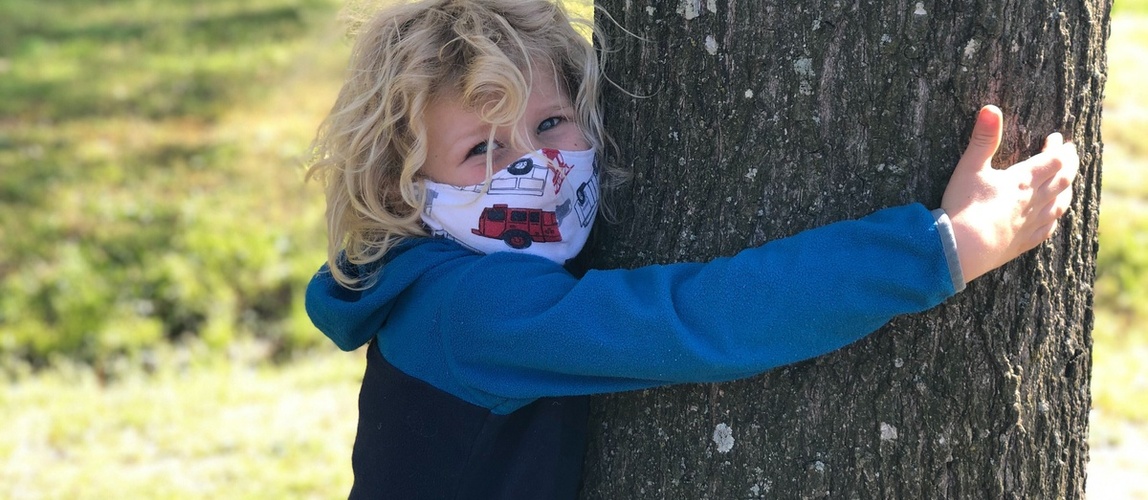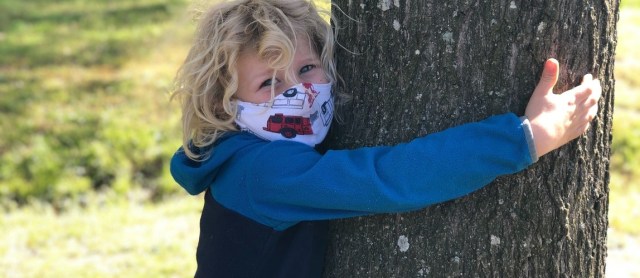
It seems clear that masks will play an important role in how we all navigate public spaces safely again. When we can’t be sure that our kids will be able to keep six feet away from people outside the family, masks can help keep them safe. They also provide us with a feeling that we are more secure when we have them on—as if a piece of our shelter-in-place cocoon stays with us as we venture out into the world.
That said, masks can be challenging. They look strange, even scary to kids. Many kids do not like to have their face touched at all, never mind by an irksome mask. This is especially true for kids whose sensory systems are extra sensitive to touch.
But, kids can make friends with masks. Humans are wired to prefer that which is familiar to us, but kids are much better than we are at accepting new things. That in mind, we can introduce masks in ways that help masks become a normal and even fun part of life. Here are a few simple steps that can make masks work for kids:
- Babies and toddlers do not need masks. The CDC does not recommend masks for children under 2 or for anyone with difficulty breathing, so it is OK not to worry about cajoling your toddler into their mask.
- Make sure kids can take off their masks. Kids older than 2 should be able to take a mask off, but that requires that you provide a mask that is easy for kids to take off. Masks that tie in the back, for example, may provide too much challenge for kids, where a mask that tucks around the ears is easier for kids to remove if needed.
- Make sure masks are comfortable. In a rush, we whipped together poorly sized masks made from particularly scratchy bandanas, safety pins, and hair ties—a bad move. It took much convincing to get our 5-year old to even try a new mask after that. Lesson learned. To the extent you can, make sure your child’s mask is soft, properly sized, and easy on the ears.
- Pick fun masks. If you can, pick masks made in colors or patterns that your kids like. The masks will be less scary—even fun to look at—in the mirror. Click here for soft and effective kid-sized masks.
- Let kids pick their masks. If you have a child who is sensitive to how clothing rests on their skin, and you are able, pick more than one soft mask and welcome your child to pick the mask that they like best. My middle child is really jazzed about this mask he can color in himself. Feeling in control of that selection can make all the difference to kids. Plus, all kids will be more likely to wear their mask if they feel it reflects them!
- Practice at home. Identify times during the day here and there for the family to wear masks at home. Keep the time short and sweet at first, then make it longer each time. Kids will build their stamina every time you practice, and they can get used to wearing their masks and to seeing you wear yours.
Sing silly songs in your mask and giggle at how funny they sound. An impromptu dance party to a favorite song can also work wonders. Take photos and send them to loved ones, or have a family video call in masks. These simple moments help them associate masks with positive and joyful feelings.
While we’re at it, mask practice can help us reinforce the rules.
When you are working on normalizing masks, you can also reinforce good practices by modeling them and explaining them to kids in gentle ways. A few examples:
- Per the CDC, you should wash your hands before and after you put on a mask, why not add “washing our hands” as a step. It can’t hurt to reinforce hand washing!.
- Experts also recommend not touching our masks, once we’re out and about. I’ve told my kids to get their mask comfortable, then don’t touch it again. Mom or Dad can take it off for you.
- For the grown-ups in your kids’ lives, remember that the CDC also recommends that we wash masks after we have used them in public. If you don’t have a washing machine at home, really hot water and soap should do the trick.
Need help finding masks for kids?
People Magazine has sizable lists with a range of mask types for kids along with this 60 plus-comprehensive list of face masks. You can also search for “organic kids mask” and find sustainable masks, too. Want to make your own? Children’s Hospital of Philadelphia has a pretty simple tutorial, and Jennifer Maker’s mask includes an optional filter pocket, too.
The idea of moving from shelter-in-place to re-open feels like a frightening leap of faith, but just like our kids, we’ll likely feel more ready if we get a chance to make friends with each of these ways to stay safe. And, through the eyes of our kids, we may even have some silly fun in the process!
